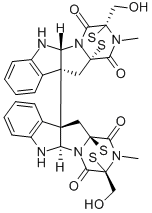Description
Chaetocin (28097-69-1) is an antimicrobial fungal metabolite. It was found to be a specific inhibitor of the lysine-specific histone methyltransferase SU(VAR)3-9 (IC50 = 0.6 mM) of Drosophila melanogaster and of its human ortholog (IC50 = 0.8 mM). It acts as a competitive inhibitor for S-adenosylmethionine. The specificity of chaetocin for SU(VAR)3-9 makes this compound an excellent tool for the study of heterochromatin-mediated gene repression. Chaetocin has an antimyeloma activity which has been linked to induction of oxidative stress and subsequent apoptosis.
Chemical Properties
Chaetocin is supplied as a crystalline solid. A stock solution may be made by dissolving the chaetocin in the solvent of choice, which should be purged with an inert gas. Chaetocin is soluble in organic solvents such as DMSO. The solubility of chaetocin in DMSO is approximately 25 mg/ml.
Uses
Chaetocin is an epithiodioxopiperazine antibiotic that has recently shown promise as a selective antitumour agent. Chaetocin is an inhibitor of lysine-specific methyltransferase SU(VAR)3-9 both in vitro and in vivo. Chaetocin is dramatically accumulated in cancer cells via a process inhibited by glutathione. Inside the cell, its activity is mediated by the imposition of oxidative stress.
Application
Chaetocin is a natural metabolite isolated from Chaetomium minutum. It is a nonspecific inhbitor of histone lysine methyltransferases which are important epigenetic enzymes . Induces apoptosis in myeloma cell lines and exhibits antiproliferative activity in mammals. Chaetocin from Chaetomium minutum has been used to determine its effects on sensitization of various cells. It has also been used to determine the biological functions of OS-induced heterochromatin formation.
General Description
Chaetocin is a fungal metabolite with antimicrobial and cytostatic activity. It belongs to the 3,6-epidithio-diketopiperazines class of which gliotoxin, sporidesmin, aranotin, oryzachloride, verticillin A and the melinacidins are members. Chaetocin is a molecular dimer of two five-membered rings cis fused. Interestingly, the chirality of the 3,6-epidithiodioxopiperazine moiety in chaetocin is opposite to the chirality of gliotoxin, sporidesmin, aranotin, and oryzachloride. Unlike these compounds, chaetocin does not have an antiviral activity. This fungal toxin showed strong cytotoxicity against HeLa cells (IC50 = 0.05 mg/ml).
Biochem/physiol Actions
Chaetocin is a competitive inhibitor for S-adenosylmethionine. The specificity of chaetocin for SU(VAR)3-9 makes this compound an excellent tool for the study of heterochromatin-mediated gene repression.
References
1) Greiner et al. (2005), Identification of a specific inhibitor of the histone methyltransferase SU(VAR)3-9; Nat. Chem. Biol., 1 143
2) Isham et al. (2007), Chaetocin: a promising new antimyeloma agent with in vitro and in vivo activity mediated via imposition of oxidative stress; Blood, 109 2579



